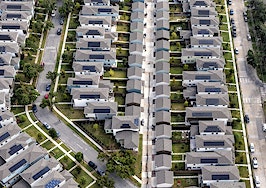Home prices surged 19.8 percent higher in February than at the same time last year, according to numbers released Tuesday as part of the S&P CoreLogic Case-Shiller U.S. National Home Price Index.
That’s an even faster annual pace than the 19.1 percent year-over-year increase recorded the previous month. Meanwhile, monthly home prices rose 1.9 percent in February, capping off the third-highest annual gain in 35 years.
These numbers reflect the state of the market from more than two months ago, shortly before Russia’s invasion of Ukraine threw financial markets into a state of uncertainty and mortgage rates shot up beyond 5 percent.
They reflected “a renewed sense of urgency” among buyers as they picked through limited inventory and tried to get ahead of rising rates, according to Realtor.com Manager of Economic Research George Ratiu.
“As we move through the spring housing market, we are seeing clear signs of cooling demand,” Ratiu wrote in an email. “Many buyers are deciding to take a step back and re-evaluate their budgets and timelines. The silver lining to the moderation in transactions is that markets seem to be stepping back from the overheated environment of the past year.”
Of the 20 major cities tracked by Case-Shiller, Phoenix and the Florida markets of Tampa and Miami saw the fastest price growth year over year. Home prices in these three cities rose by approximately 30 percent or more in the 12 months leading up to February.
The picture painted by Case-Shiller was similar to that from the latest Federal Housing Finance Agency House Price Index report, also released on Tuesday. The national median home price rose 19.4 percent year over year, according to this measure — breaking the previous month’s record of 18.2 percent.
Amongst the nine census divisions, the Mountain division led annual home price growth with a 24.3 percent increase, while the East North Central shored up the end of the pack with a 15.3 percent increase.
On a monthly basis, the South Atlantic division experienced the biggest bump in home prices from January to February at 2.9 percent. Meanwhile, the East North Central division once again logged the slowest growth at 1.3 percent.
“House prices rose to set a new historical record in February,” FHFA Supervisory Economist Will Doerner said in a written statement. “Acceleration approached twice the monthly rate as seen a year ago. Housing prices continue to rise owing in part to supply constraints.”
The red-hot market conditions throughout much of the last year have created tough problems for buyers and interesting — but still tricky — opportunities for sellers, Ratiu said.
“For sellers, rising prices offer a welcome environment for cashing out equity,” Ratiu said in the statement. “However, since most sellers are also buyers, they are facing a similar conundrum, as their next homes also carry higher price tags and interest rates.”
At the edges, there are signs that the economic tapestry supporting this period of red-hot home price growth may be starting to fray, said Craig J. Lazzara, managing director at S&P DJI.
Mortgage rates have already bounced back from their all-time lows during the pandemic. Once below 3 percent, they’re now averaging well above 5 percent, according to Optimal Blue, a mortgage industry service provider.
At the same time, prices of consumer goods and services have been rising at the fastest pace in four decades, and U.S. central bank officials have taken notice. The Federal Reserve is preparing to hike interest rates and shrink its balance sheet in an effort to keep inflation in check, which could have effects on the home market.
“The macroeconomic environment is evolving rapidly and may not support extraordinary home price growth for much longer,” Lazzara said in the report.
In an April 19 forecast, Fannie Mae economists said they expect home price appreciation to return to the single digits by next year, dropping to 3.2 percent by the final three months of 2023 with the potential for a “modest recession” in the second half of the year.













